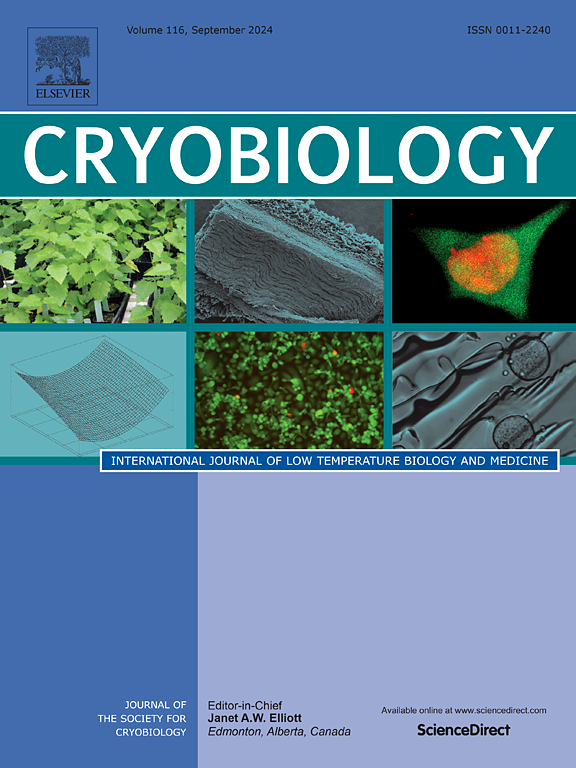海藻糖对冷冻苹果果脯理化和显微结构稳定性的冷冻保护作用
IF 2.1
3区 生物学
Q2 BIOLOGY
引用次数: 0
摘要
冷冻是水果类产品的常用保存方法,但往往会导致冰晶形成和结构破坏而导致质量下降。本研究旨在评价海藻糖在- 18°C条件下对苹果果肉在30 d内的物理化学和微观结构稳定性的冷冻保护作用。以0%、1%和5% (w/w)浓度的海藻糖制备苹果样品,研究海藻糖在减少滴漏、保持微观结构、保持营养和质地品质方面的效果。除了评估灰分含量、pH值、总可溶性固结物(TSS)、总酚含量(TPC)、抗氧化能力(DPPH)和颜色参数外,评估的主要质量属性还包括滴漏损失、水分保持、质地相关特性和微观结构。结果表明,海藻糖显著减轻了滴漏损失,与对照组(14.8%)相比,5%处理达到最低值(6.0%),这表明海藻糖增强了水结合能力,减少了冰晶引起的细胞损伤。显微分析表明,海藻糖处理后的样品结构崩塌减少,实质完整性得以保存,这有助于改善解冻后的质地一致性。此外,含有海藻糖的样品显示出更好的TPC保留,抗氧化活性和颜色,突出海藻糖对氧化和热降解的保护作用。这些发现强调了海藻糖作为冷冻水果系统中冷冻保护剂的潜力,通过结构稳定和水分管理来提高最低限度加工水果产品的质量。本文章由计算机程序翻译,如有差异,请以英文原文为准。
Cryoprotective effects of trehalose on the physicochemical and microstructural stability of frozen apple purée
Freezing is a common preservation method for fruit-based products but often leads to quality degradation caused by ice crystal formation and structural damage. This study aimed to evaluate the cryoprotective effects of trehalose on the physicochemical and microstructural stability of apple purée during 30 days of frozen storage at −18 °C. Apple purée samples were prepared with trehalose at concentrations of 0 %, 1 %, and 5 % (w/w) to investigate its efficacy in reducing drip loss, preserving microstructure, and maintaining nutritional and textural quality. Key quality attributes assessed included drip loss, moisture retention, texture-related properties, and microstructure, in addition to evaluating ash content, pH, total soluble solids (TSS), total phenolic content (TPC), antioxidant capacity (DPPH), and color parameters. Results indicated that trehalose significantly mitigated drip loss, with the 5 % treatment achieving the lowest value (6.0 %) compared to the control (14.8 %), suggesting enhanced water-binding capacity and reduced ice crystal-induced cellular damage. Microscopic analysis revealed that trehalose-treated samples exhibited reduced structural collapse and preserved parenchymal integrity, which contributed to improved textural consistency post-thaw. Furthermore, samples with trehalose showed better retention of TPC, antioxidant activity, and color, highlighting trehalose's protective role against oxidative and thermal degradation. These findings underscore the potential of trehalose as a cryoprotective agent in frozen fruit systems, with direct implications for improving the quality of minimally processed fruit products through structural stabilization and moisture management.
求助全文
通过发布文献求助,成功后即可免费获取论文全文。
去求助
来源期刊

Cryobiology
生物-生理学
CiteScore
5.40
自引率
7.40%
发文量
71
审稿时长
56 days
期刊介绍:
Cryobiology: International Journal of Low Temperature Biology and Medicine publishes research articles on all aspects of low temperature biology and medicine.
Research Areas include:
• Cryoprotective additives and their pharmacological actions
• Cryosurgery
• Freeze-drying
• Freezing
• Frost hardiness in plants
• Hibernation
• Hypothermia
• Medical applications of reduced temperature
• Perfusion of organs
• All pertinent methodologies
Cryobiology is the official journal of the Society for Cryobiology.
 求助内容:
求助内容: 应助结果提醒方式:
应助结果提醒方式:


